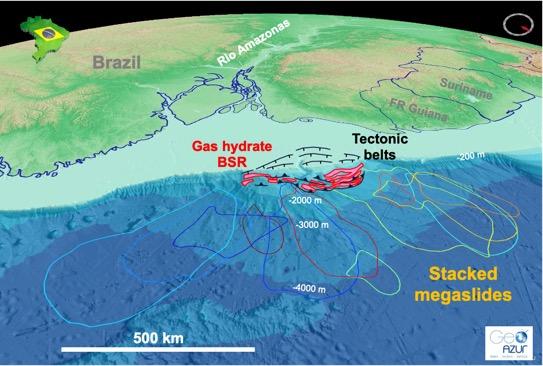VT 181 / AMARYLLIS-AMAGAS I
| Type | Oceanographic cruise |
|---|---|
| Ship | Marion Dufresne |
| Ship owner | TAAF |
| Dates | 16/05/2023 - 11/06/2023 |
| Chief scientist(s) | PRAEG Daniel  , MIGEON Sébastien , MIGEON Sébastien |
LABORATOIRE GEOAZUR - UMR 7329 / UR082 250 rue Albert Einstein CS 10269 Campus Azur 06905 Sophia-Antipolis +33 (0)4 92 94 26 02 |
|
| DOI | 10.17600/18003361 |
| Objective | Degassing of the Amazon deep-sea fan and the dynamics of its upper slope gas hydrate system in relation to giant landslide triggering The deep-sea fans of large rivers act as major carbon sinks, but the role of gas hydrates in releasing carbon through processes of fluid expulsion and mass failure remains poorly understood. The Amazon River has the world's highest flux of organic-rich sediment to the ocean and over the last 8 million years has constructed a deep-sea fan up to 10 km thick that offers a natural laboratory to examine fluid-sediment interactions. The Amazon fan is a dynamic feature that undergoes different forms of large-scale slope instability (gravity tectonics on deep detachments, recurrent giant landslides). A thrust-fold belt on the upper slope hosts a gas hydrate system, as well as gas flares rising into the water column from seafloor fluid vents (mounds and depressions). The full extent of degassing is unknown, as water column acoustic data is only available across part of the fan above depths of 2000 m. Giant landslides dated during ODP 155 have been hypothesised to result from the climate-driven destabilisation of gas hydrates during changes in global sea (`top-down' dynamics), but gas hydrate stability may also be influenced by tectonism and fluid expulsion within the thrust-fold belt (`bottom-up' dynamics). The AMARYLLIS-AMAGAS I campaign involved two main objectives : 1) at the scale of the fan as a whole, to assess the depth distribution and activity of seafloor fluid vents; 2) within the upper slope thrust-fold belt, to constrain models of `top-down' and `bottom-up' gas hydrate dynamics and their consequences for landslide triggering over glacial-interglacial timescales. The first objective involved hydroacoustic methods : the acquisition of multibeam data and subbottom profiles along multiple transects of the fan, across water depths of 50-4100 m, to identify water column gas flares and features of seafloor fluid venting; to detect temporal changes in activity, the transects cross fluid vents previously imaged on the upper fan. The second objective involved multi-disciplinary methods : the acquisition of sediment cores and heat flow data from targets on the upper fan, including landslides and seafloor fluid vents, in order to characterise their activity and obtain samples of failed vs unfailed sediments, extrusive deposits, authigenic carbonates, gas hydrates and pore fluids and gases. Stratigraphic, sedimentological, geochemical, geotechnical and geothermal analyses of the data acquired will provide input to modelling of gas hydrate and landslide dynamics to be undertaken in the context of the ANR project MEGA (2023-2026). The campaign involved strong international collaboration, with 37 participants from research organisations in France (60%), Brazil (30%), Sweden, Germany and Japan, reflecting its strategic objective of reinforcing Franco-Brazilian collaboration on fluid-sediment interactions on continental margins.
|

